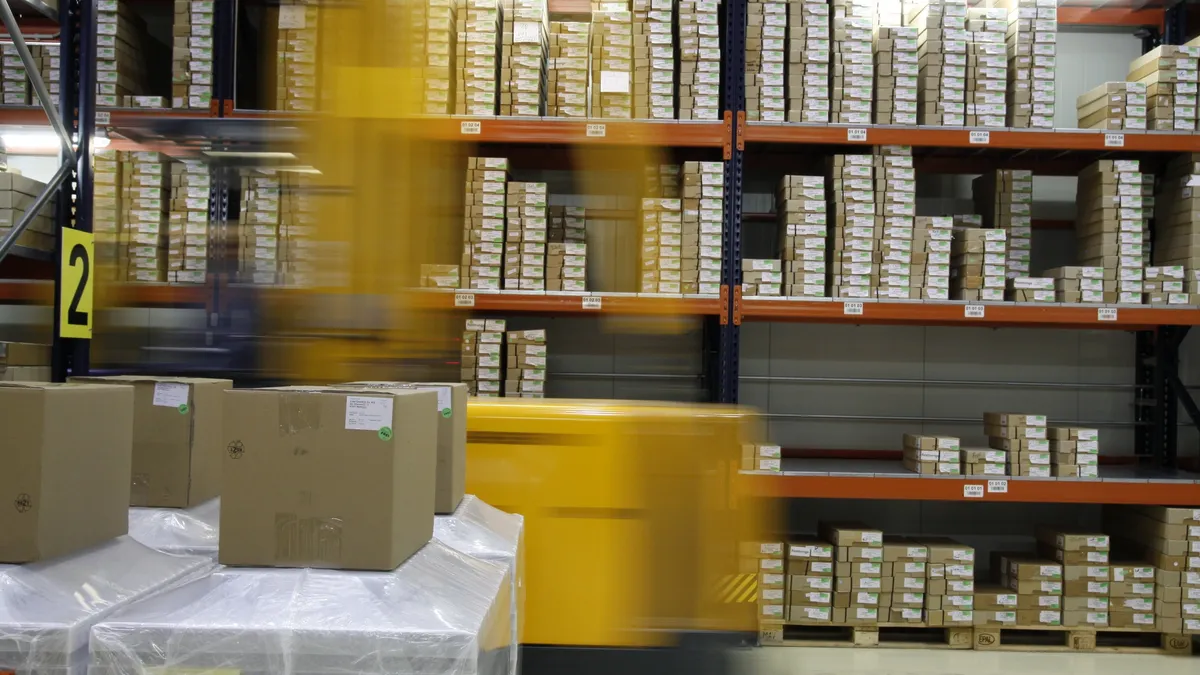Dive Brief:
- Many companies were caught flat-footed in the face of demands presented by the coronavirus pandemic, according to a recent survey by GlobalTranz and Edelman, which found that 41% of respondents felt unprepared for shifting store locations into fulfillment hubs.
- The survey found that 90% of respondents had enhanced their e-commerce capabilities as a result of the pandemic.
- It also found that 87% of respondents adopted omnichannel operations as a result of the pandemic. But 35% felt unprepared when it came to their omnichannel strategy for adjusting to consumer behavior.

Dive Insight:
Retailers scrambled to change their fulfillment operations as the coronavirus pandemic gripped the country. Stores shut down, and those left open had to figure out a way to get their inventory to online shoppers. In April, Levi's began increasing its ship-from-store operation. By June, Nike said it had tripled its digital fulfillment capacity.
"Nobody's prepared for this," Moody's lead retail analyst Charles O'Shea said, referring to what companies have gone through during the pandemic.
Even retailers like Home Depot and Walmart that have excelled during natural disasters struggled to get operations right as consumer demand shifted dramatically in 2020. In a natural disaster, a retailer deploys its essential products into the locally affected area. The pandemic didn't allow retailers to follow this model of disaster preparedness, O'Shea said.
"You couldn't move things geographically because you had to keep things pretty balanced," he said. "Retailers were trying to stock a whole network, rather than redeploying. So, that made things a little bit tough."
Unsurprisingly, the retailers who have managed store-based fulfillment the best were the ones that had already invested in it, O'Shea said.
One company that has been touting its store-based model for years is Target. And the retailer has underscored on recent earnings calls how those investments have paid off during the pandemic.
"Of this year's digital growth, sales on orders shipped from stores have grown more than $1.6 billion," Target COO John Mulligan said on the company's August earnings call. "Sales from our pickup and drive-up services have also grown more than $1.6 billion so far this year, with drive up accounting for well over $1 billion of that growth."
For those without the experience, there are challenges from an operational and logistical perspective, according to GlobalTranz Director of Customer Solutions Karen Tyndall.
On the operations side of the house, a retailer has to consider space, staffing and inventory technology. It can be difficult for many retail stores to turn small spaces in strip malls or other locations into facilities that can fulfill online orders, which requires room for packing and labeling the orders. Staffing requirements could also increase, as workers will be needed to complete packing while others handle the traditional front of house duties, Tyndall said.
Retailers must also consider their procurement needs, when it comes to packaging. O'Shea recalled talking with one specialty retailer that ran out of boxes when it began offering ship from store.
"The stores were running to Office Depot, OfficeMax, you know, wherever to get shipping boxes because they didn't expect that they would need as many as they did," he said.
But retailers with multiple locations will also need to think about how they will handle potential split shipments from multiple locations, Tyndall said, adding that many customers are willing to get multiple shipments if it means they arrive faster.
"When companies are assessing how to make that transition into a more dynamic omnichannel type of distribution model, they've first got to make sure that they have a really robust visibility to their internal inventory," she said.
The survey also found that 74% of respondents are now more likely to work with a managed transportation provider. Tyndall said it can be hard for retailers, who are used to handling in-bound logistics, to find capacity for out-bound orders.
"You're talking about a greater number of orders going out from a higher number of locations," she said, "and for the parcel carriers that are arranging those types of pickups, that can be a challenge in and of itself."
As more volume flows into the parcel network, more larger items are getting rejected, she said. This has resulted in carriers having to figure out a way to handle these orders either through LTL or full truckload shipments.
But not every retailer should aim to have grade A ship-from-store operations, because it costs much more than making a traditional sale of other omnichannel offerings, O'Shea said.
"We are in ... a pandemic-driven experimentation phase for retailers," he said. "They're literally drinking out of a firehose, and they're trying to figure out" how to prepare their operations for the future.
This story was first published in our weekly newsletter, Supply Chain Dive: Operations. Sign up here.















